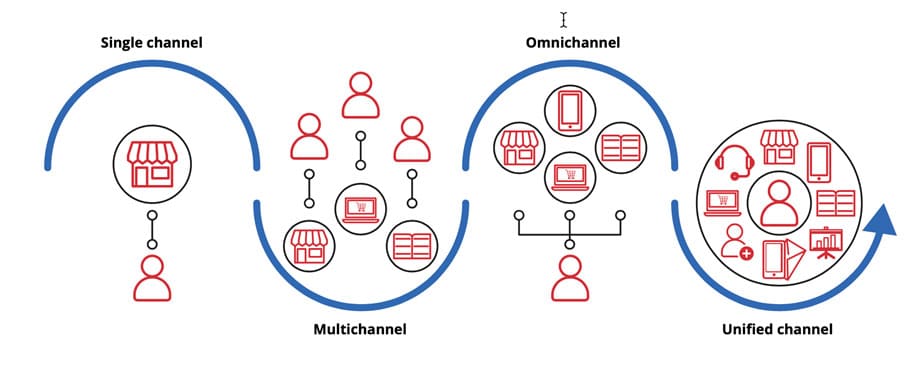Today’s customers want it all. They want to be able to go online and easily find products, prices and delivery information. But they also want to be able to call with questions and speak to a knowledgeable service rep. Some still want to look at pictures in a catalog.
But no matter how they interact with you, they want it to be seamless.
A McKinsey study showed that B2B buyers are using 10 channels now vs. just five in 2016. And 94% of B2B users say new omnichannel methods are as effective or more effective than pre-COVID. In other words: Buyers don’t want it to return to the way it was before the pandemic.
Download Now: Best Practices in Building an Omnichannel Experience
What’s the difference between omnichannel and multichannel?
What separates an omnichannel customer experience that most buyers are looking for today from mere multichannel is integration. The same buyer will move back and forth from one sales channel to another.
Creating an omnichannel infrastructure means your customer’s experience is consistent, no matter how they interact with you. It means the entire shopping, sales and service process is linked, and every interaction along that path, and how your company responded, is immediately accessible to any front-line employee. And the status of an order placed offline with a sales rep can be checked online and vice versa.
It’s important to remember that, from a customer’s point of view, an omnichannel experience isn’t just shopping or buying. Rather, it is every occasion a customer has to connect with a distributor.

Examples of Omnichannel
One example of an omnichannel experience is a repair. A customer who needs a repair may start by going to your website, and if the option is available, may chat online with a service rep. But if the issue is complicated, it may require the involvement of a distributor support expert.
That conversation will proceed much more smoothly and more likely result in a solution for the customer, if that expert can instantly access a history of the customer’s purchases and inventory.
Another example is in the buying and fulfillment process. Let’s say a contractor finds the products they need on a distributor’s website, but then orders those products through a mobile app. They need the product right away, so they then go to the branch and show the order to a rep behind the counter. That rep then brings up the transaction to complete the order.
Each of those steps requires near-immediate information sharing, which must be supported by your technology setup. A problem at any step in that process will detract from a distributor’s ability to provide a seamless customer experience.
How to Build an Omnichannel Strategy
To offer that kind of seamless experience means distributors first must build a strategy that allows customers to shop when, where and how they want, whether it is digital, in person, in print, or in some combination of all those. Start by:
- Identifying and prioritizing top customer cross-channel journeys, tapping into analytics from across your organization. Journeys are complex, and may include bouncing back and forth between your channels, as well as third-party channels, to make a buying decision.
- Designing experiences for key customer journeys. For high-priority customer journeys that use multiple channels, build the capabilities they need.
- Embedding a customer-centric mindset. If customers are at the core of your omnichannel capabilities, it will help you select the right technology and find the right people to deliver what customers need.
An omnichannel strategy must be built on a solid infrastructure, including tools like CRM, marketing automation, click-to-chat and other technology that can drive the experience a customer is looking for.
Omnichannel: A Requirement for Survival
Don’t make the mistake of assuming all customers want the same thing. Or that a particular customer will always want to shop, order and communicate with you in the same using the same channel. Market research has shown time and again that buyers now prefer search for shopping and email for ordering, but they all shop and buy across all other channels.
Channel boundaries are dissolving.
Many larger distributors already offer these seamless experiences, and they are taking market share from smaller competitors. Compelling omnichannel experiences are a requirement to survive and should begin with a key focus on what drives value for your customers.
The results for any distributor that does this well?
- Competitive advantage
- Cost savings through greater efficiencies
- Increased customer satisfaction
- Profitable sales growth
Want to learn more about how to build the right omnichannel strategy for your business? Access our free webinar, True Omnichannel, Part 1 – Best Practices in Omnichannel and Unified Commerce.
Jonathan Bein, Ph.D. is Managing Partner at Distribution Strategy Group. He’s
developed customer-facing analytics approaches for customer segmentation,
customer lifecycle management, positioning and messaging, pricing and channel strategy for distributors that want to align their sales and marketing resources with how their customers want to shop and buy. If you’re ready to drive real ROI, reach out to Jonathan today at
jbein@distributionstrategy.com.
